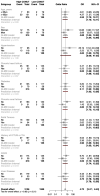Controlling Nutritional Status (CONUT) Score as a Potential Prognostic Indicator of In-Hospital Mortality, Sepsis and Length of Stay in an Internal Medicine Department
- PMID: 37049392
- PMCID: PMC10096657
- DOI: 10.3390/nu15071554
Controlling Nutritional Status (CONUT) Score as a Potential Prognostic Indicator of In-Hospital Mortality, Sepsis and Length of Stay in an Internal Medicine Department
Abstract
The controlling nutritional status (CONUT) score represents poor nutritional status and has been identified as an indicator of adverse outcomes. Our aim was to evaluate the prognostic role of the CONUT score on in-hospital outcomes in an Internal Medicine Department. This is a retrospective study analyzing data from 369 patients, divided into four groups based on the CONUT score: normal (0-1), mild-high (2-4), moderate-high (5-8), and marked high (9-12). In-hospital all-cause mortality increased from normal to marked high CONUT score group (2.2% vs. 3.6% vs. 13.4% vs. 15.3%, p < 0.009). Furthermore, a higher CONUT score was linked to a longer length of hospital stay (LOS) (9.48 ± 6.22 vs. 11.09 ± 7.11 vs. 12.45 ± 7.88 vs. 13.10 ± 8.12, p < 0.013) and an increased prevalence of sepsis. The excess risk of a high CONUT score relative to a low CONUT score remained significant after adjusting for confounders (all-cause mortality: OR: 3.3, 95% CI: 1.1-9.7, p < 0.02; sepsis: OR: 2.7, 95% CI: 1.5-4.9, p < 0.01; LOS: OR: 2.1, 95% CI: 1.2-3.9, p < 0.007). The present study demonstrated that an increased CONUT score is related to a higher risk of short-term in-hospital death and complications.
Keywords: CONUT score; in-hospital outcomes; internal medicine; malnutrition.
Conflict of interest statement
The authors declare no conflict of interest.
Figures




Similar articles
-
Malnutrition-Related Liver Steatosis, CONUT Score and Poor Clinical Outcomes in an Internal Medicine Department.Nutrients. 2024 Jun 18;16(12):1925. doi: 10.3390/nu16121925. Nutrients. 2024. PMID: 38931279 Free PMC article.
-
COntrolling NUTritional Status (CONUT) as Predictive Score of Hospital Length of Stay (LOS) and Mortality: A Prospective Cohort Study in an Internal Medicine and Gastroenterology Unit in Italy.Nutrients. 2023 Mar 19;15(6):1472. doi: 10.3390/nu15061472. Nutrients. 2023. PMID: 36986202 Free PMC article.
-
Prognostic impact of CONUT score in older patients with chronic heart failure.BMC Geriatr. 2024 Sep 5;24(1):738. doi: 10.1186/s12877-024-05330-5. BMC Geriatr. 2024. PMID: 39237869 Free PMC article.
-
Prognostic Potential of the Controlling Nutritional Status (CONUT) Score in Predicting All-Cause Mortality and Major Adverse Cardiovascular Events in Patients With Coronary Artery Disease: A Meta-Analysis.Front Nutr. 2022 May 9;9:850641. doi: 10.3389/fnut.2022.850641. eCollection 2022. Front Nutr. 2022. PMID: 35614981 Free PMC article.
-
Controlling Nutritional Status (CONUT) score and the risk of mortality or impaired physical function in stroke patients: A systematic review and meta-analysis.Nutr Metab Cardiovasc Dis. 2023 Aug;33(8):1501-1510. doi: 10.1016/j.numecd.2023.05.012. Epub 2023 May 12. Nutr Metab Cardiovasc Dis. 2023. PMID: 37336716
Cited by
-
Malnutrition-Related Liver Steatosis, CONUT Score and Poor Clinical Outcomes in an Internal Medicine Department.Nutrients. 2024 Jun 18;16(12):1925. doi: 10.3390/nu16121925. Nutrients. 2024. PMID: 38931279 Free PMC article.
-
Refining Nutritional Assessment Methods for Older Adults: A Pilot Study on Sicilian Long-Living Individuals.Nutrients. 2025 May 30;17(11):1873. doi: 10.3390/nu17111873. Nutrients. 2025. PMID: 40507142 Free PMC article.
-
Controlling Nutritional Status Score as a Predictor for Chronic Obstructive Pulmonary Disease Exacerbation Risk in Elderly Patients.Metabolites. 2023 Nov 2;13(11):1123. doi: 10.3390/metabo13111123. Metabolites. 2023. PMID: 37999219 Free PMC article.
-
Advanced Lung Cancer Inflammation Index as Predictor of All-Cause Mortality in ST-Elevation Myocardial Infarction Patients Undergoing Primary Percutaneous Coronary Intervention.J Clin Med. 2024 Oct 11;13(20):6059. doi: 10.3390/jcm13206059. J Clin Med. 2024. PMID: 39458009 Free PMC article.
-
Association between Controlling Nutritional Status (CONUT) Score and Body Composition, Inflammation and Frailty in Hospitalized Elderly Patients.Nutrients. 2024 Feb 20;16(5):576. doi: 10.3390/nu16050576. Nutrients. 2024. PMID: 38474705 Free PMC article.
References
-
- Cereda E., Pedrolli C., Klersy C., Bonardi C., Quarleri L., Cappello S., Turri A., Rondanelli M., Caccialanza R. Nutritional Status in Older Persons According to Healthcare Setting: A Systematic Review and Meta-Analysis of Prevalence Data Using MNA®. Clin. Nutr. 2016;35:1282–1290. doi: 10.1016/j.clnu.2016.03.008. - DOI - PubMed
MeSH terms
LinkOut - more resources
Full Text Sources
Medical

